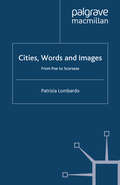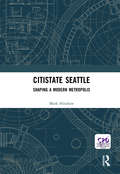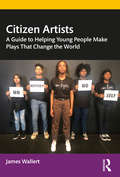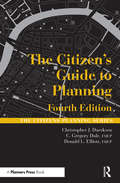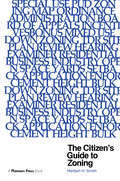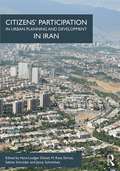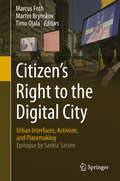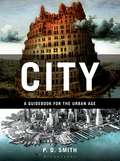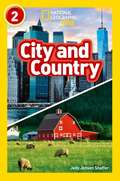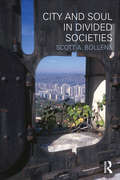- Table View
- List View
Cities, Words and Images: From Poe to Scorsese (Language, Discourse, Society)
by P. LombardoThe city is an essential theme of modernity in literature, architecture, photography and film. This book first focuses on ardent reactions to the metropolitan explosion in the nineteenth century, with Baudelaire and Poe as key figures. More recent representations of the city are then investigated, in Europe and the United States. Lombardo reflects on the way in which the changes in human perception created by urbanization are expressed in the various arts, in terms of form and content.
Citistate Seattle: Shaping A Modern Metropolis
by Mark HinshawWith style and humor, the author writes of special places in everyday Seattle. The author takes us to popular, high-profile landmarks like Pike Place Market as well as tucked-away gems — cozy cottages, trendy pubs, gracious apartment buildings, and vibrant urban villages — that flavor and enliven the city. The author shares his eye for unique, humanizing details of design, architecture, and function, bringing this colorful metropolis to life so vividly you'll practically smell the coffee they brew and sell on (almost) every street corner. Along the way, the author explains the public and private decisions that helped Seattle avoid the urban desolation that plagues other American cities. The author introduces many of Seattle's movers and shakers — mayors, developers, artists, and urban pioneers — who took it upon themselves to guide metropolitan Seattle along a different path.
Citistate Seattle: Shaping A Modern Metropolis
by Mark HinshawWith style and humor, the author writes of special places in everyday Seattle. The author takes us to popular, high-profile landmarks like Pike Place Market as well as tucked-away gems — cozy cottages, trendy pubs, gracious apartment buildings, and vibrant urban villages — that flavor and enliven the city. The author shares his eye for unique, humanizing details of design, architecture, and function, bringing this colorful metropolis to life so vividly you'll practically smell the coffee they brew and sell on (almost) every street corner. Along the way, the author explains the public and private decisions that helped Seattle avoid the urban desolation that plagues other American cities. The author introduces many of Seattle's movers and shakers — mayors, developers, artists, and urban pioneers — who took it upon themselves to guide metropolitan Seattle along a different path.
Citizen Artists: A Guide to Helping Young People Make Plays That Change the World
by James WallertCitizen Artists takes the reader on a journey through the process of producing, funding, researching, creating, rehearsing, directing, performing, and touring student-driven plays about social justice. The process at the heart of this book was developed from 2015–2021 at New York City’s award-winning Epic Theatre Ensemble with and for their youth ensemble: Epic NEXT. Author and Epic Co-Founder James Wallert shares his company’s unique, internationally recognized methodology for training young arts leaders in playwriting, inquiry-based research, verbatim theatre, devising, applied theatre, and performance. Readers will find four original plays, seven complete timed-to-the-minute lesson plans, 36 theatre arts exercises, and pages of practical advice from more than two dozen professional teaching artists to use for their own theatre making, arts instruction, or youth organizing. Citizen Artists is a one-of-a-kind resource for students interested in learning about theatre and social justice; educators interested in fostering learning environments that are more rigorous, democratic, and culturally-responsive; and artists interested in creating work for new audiences that is more inclusive, courageous, and anti-racist.
Citizen Artists: A Guide to Helping Young People Make Plays That Change the World
by James WallertCitizen Artists takes the reader on a journey through the process of producing, funding, researching, creating, rehearsing, directing, performing, and touring student-driven plays about social justice. The process at the heart of this book was developed from 2015–2021 at New York City’s award-winning Epic Theatre Ensemble with and for their youth ensemble: Epic NEXT. Author and Epic Co-Founder James Wallert shares his company’s unique, internationally recognized methodology for training young arts leaders in playwriting, inquiry-based research, verbatim theatre, devising, applied theatre, and performance. Readers will find four original plays, seven complete timed-to-the-minute lesson plans, 36 theatre arts exercises, and pages of practical advice from more than two dozen professional teaching artists to use for their own theatre making, arts instruction, or youth organizing. Citizen Artists is a one-of-a-kind resource for students interested in learning about theatre and social justice; educators interested in fostering learning environments that are more rigorous, democratic, and culturally-responsive; and artists interested in creating work for new audiences that is more inclusive, courageous, and anti-racist.
The Citizen Audience: Crowds, Publics, and Individuals
by Richard ButschIn The Citizen Audience, Richard Butsch explores the cultural and political history of audiences in the United States from the nineteenth century to the present. He demonstrates that, while attitudes toward audiences have shifted over time, Americans have always judged audiences against standards of good citizenship. From descriptions of tightly packed crowds in early American theaters to the contemporary reports of distant, anonymous Internet audiences, Butsch examines how audiences were represented in contemporary discourse. He explores a broad range of sources on theater, movies, propaganda, advertising, broadcast journalism, and much more. Butsch discovers that audiences were characterized according to three recurrent motifs: as crowds and as isolated individuals in a mass, both of which were considered bad, and as publics which were considered ideal audiences. These images were based on and reinforced class and other social hierarchies. At times though, subordinate groups challenged their negative characterization in these images, and countered with their own interpretations. A remarkable work of cultural criticism and media history, this book is essential reading for anyone seeking an historical understanding of how audiences, media and entertainment function in the American cultural and political imagination.
The Citizen Audience: Crowds, Publics, and Individuals
by Richard ButschIn The Citizen Audience, Richard Butsch explores the cultural and political history of audiences in the United States from the nineteenth century to the present. He demonstrates that, while attitudes toward audiences have shifted over time, Americans have always judged audiences against standards of good citizenship. From descriptions of tightly packed crowds in early American theaters to the contemporary reports of distant, anonymous Internet audiences, Butsch examines how audiences were represented in contemporary discourse. He explores a broad range of sources on theater, movies, propaganda, advertising, broadcast journalism, and much more. Butsch discovers that audiences were characterized according to three recurrent motifs: as crowds and as isolated individuals in a mass, both of which were considered bad, and as publics which were considered ideal audiences. These images were based on and reinforced class and other social hierarchies. At times though, subordinate groups challenged their negative characterization in these images, and countered with their own interpretations. A remarkable work of cultural criticism and media history, this book is essential reading for anyone seeking an historical understanding of how audiences, media and entertainment function in the American cultural and political imagination.
The Citizen Journalist's Photography Handbook: Shooting the World As it Happens
by Carlos MillerWith dramatic and exciting stories, Carlos Miller reveals the secrets behind successful citizen journalism.Whether you're planning a publicity blitz for your cause, you're interested in the down-and-dirty practices of the police, or just want to be prepared for the moment you're the first on the scene, this book has everything you'll need to know to take newsworthy pictures and get them in front of a wide audience.You don't need a DSLR camera - though they can be useful - what is essential for citizen journalism is a cool head, an eye for a great angle, and the initiative to capture the moment: let Carlos Miller show you how.
Citizen Kane (BFI Film Classics)
by Laura MulveyCitizen Kane's reputation as one of the greatest films of all time is matched only by the accumulation of critical commentary that surrounds it. What more can there be to say about a masterpiece so universally acknowledged? Laura Mulvey, in a fresh and original reading, illuminates the richness of the film, both thematically and stylistically, relating it to Welles's political background and its historical context. In a lucid and perceptive critique she also investigates the psychoanalytic structure that underlies the film's presentation of Kane's biography, for once taking seriously what Orson Welles himself disparagingly referred to as 'dollar-book Freud.' In her foreword to this special edition, published to celebrate the 20th anniversary of the BFI Film Classics series, Laura Mulvey focuses on the film's politics, highlighting the contemporary 'rhymes' in Kane's portrayal of a scandal-prone press baron in a time of economic crisis.
The Citizen's Guide to Planning
by Christopher Duerksen Gregory C Dale Donald L ElliottAPA's popular primer for citizens is all new! For decades, planning officials and engaged citizens have relied on this book for a better understanding of the basics of planning. Now the authors have revised this perennial bestseller into a 21st-century guide for anyone who wants to make his or her community a better place. This book describes the land-use planning process, the key players in that process, and the legal framework in which decisions are made. The authors advocate principles and disciplines that will help those involved in the process make good decisions. In easy-to-understand language, they offer nuts-and-bolts information about different types of plans and how they are implemented. Chapters cover the goals and values of planning, the history of planning, the different people and organizations involved, the creation and implementation of a comprehensive plan, sustainability, the application review process, and legal and ethical questions.
The Citizen's Guide to Planning
by Christopher Duerksen Gregory C Dale Donald L ElliottAPA's popular primer for citizens is all new! For decades, planning officials and engaged citizens have relied on this book for a better understanding of the basics of planning. Now the authors have revised this perennial bestseller into a 21st-century guide for anyone who wants to make his or her community a better place. This book describes the land-use planning process, the key players in that process, and the legal framework in which decisions are made. The authors advocate principles and disciplines that will help those involved in the process make good decisions. In easy-to-understand language, they offer nuts-and-bolts information about different types of plans and how they are implemented. Chapters cover the goals and values of planning, the history of planning, the different people and organizations involved, the creation and implementation of a comprehensive plan, sustainability, the application review process, and legal and ethical questions.
Citizen's Guide to Zoning
by Herbert SmithFirst published in 1983. Routledge is an imprint of Taylor & Francis, an informa company. An easy-to-read book about zoning that cuts the jargon out but leaves the wisdom in. Smith explains the fundamental principles of zoning, how to develop zoning regulations, and the nuts and bolts of a zoning ordinance. He examines variances, zoning hearings, and frequent zoning problems.
Citizen's Guide to Zoning
by Herbert SmithFirst published in 1983. Routledge is an imprint of Taylor & Francis, an informa company. An easy-to-read book about zoning that cuts the jargon out but leaves the wisdom in. Smith explains the fundamental principles of zoning, how to develop zoning regulations, and the nuts and bolts of a zoning ordinance. He examines variances, zoning hearings, and frequent zoning problems.
Citizens' Participation in Urban Planning and Development in Iran
by Hans-Liudger Dienel M. Reza Shirazi Sabine Schröder Jenny SchmithalsDuring recent years, the topic of participation has increasingly been gaining importance in Iran – in the scientific field, in practice and rhetoric. However, in current scientific literature – and especially in English literature – there is little knowledge on the conditions, legal background, perceptions, experiences and processes of citizens’ participation in Iran. This book aims to shed light on the paradoxical question of participation in Iran: it is old and new, dysfunctioning and functioning, disappointing and promising. This slippery status of participation convinces scholars to suggest contradictory interpretations and understandings about the existence, functionality, and potentiality of this concept. The book therefore shows the different perspectives, interpretations, historical developments and case studies of participation in Iran, thus giving the reader a kaleidoscope view on the question of participation in Iran.
Citizens' Participation in Urban Planning and Development in Iran
by Dienel HansLiudgerDuring recent years, the topic of participation has increasingly been gaining importance in Iran – in the scientific field, in practice and rhetoric. However, in current scientific literature – and especially in English literature – there is little knowledge on the conditions, legal background, perceptions, experiences and processes of citizens’ participation in Iran. This book aims to shed light on the paradoxical question of participation in Iran: it is old and new, dysfunctioning and functioning, disappointing and promising. This slippery status of participation convinces scholars to suggest contradictory interpretations and understandings about the existence, functionality, and potentiality of this concept. The book therefore shows the different perspectives, interpretations, historical developments and case studies of participation in Iran, thus giving the reader a kaleidoscope view on the question of participation in Iran.
Citizen’s Right to the Digital City: Urban Interfaces, Activism, and Placemaking
by Marcus Foth Martin Brynskov Timo OjalaEdited by thought leaders in the fields of urban informatics and urban interaction design, this book brings together case studies and examples from around the world to discuss the role that urban interfaces, citizen action, and city making play in the quest to create and maintain not only secure and resilient, but productive, sustainable and viable urban environments. The book debates the impact of these trends on theory, policy and practice. The individual chapters are based on blind peer reviewed contributions by leading researchers working at the intersection of the social / cultural, technical / digital, and physical / spatial domains of urbanism scholarship. The book will appeal not only to researchers and students, but also to a vast number of practitioners in the private and public sector interested in accessible content that clearly and rigorously analyses the potential offered by urban interfaces, mobile technology, and location-based services in the context of engaging people with open, smart and participatory urban environments.
The Citron Compendium: The Citron (Etrog) Citrus medica L.: Science and Tradition
by Eliezer E. Goldschmidt Moshe Bar-JosephThis comprehensive book covers the theoretical and practical aspects of citron trees and fruit. The citron (Citrus medica L.), one of the three primary species ancestral to most citrus types, is used for traditional medicine and is highly revered in the Jewish religion during the Tabernacles feast, referred to by the name 'Etrog'. This book’s three sections address biology (botany, genomics, Chinese and Mediterranean citrons, diseases, pests, and horticulture), tradition (Talmudic discourse, mysticism, medicine, literature, art, food, and beverages) and history (archaeology, trade, grafting controversies); these sections are supplemented by a glossary and pictorial album. The 22 chapters, some new and some translated and considerably expanded from the 2018 Hebrew edition, were written by world-renowned specialists from Israel, Italy, France, the U.S.A., China and Australia. The book is written in an accessible scientific style aimed at a wide range of readers.
The City: A Vision in Woodcuts (Dover Fine Art, History Of Art Series)
by Frans Masereel"An absolute song for an ongoing visit with timelessness." — The New York TimesThis graphic novel by an Expressionist master offers a stunning depiction of urban Europe between the world wars. First published in Germany in 1925, it presents unforgettable images from the tense and dynamic Weimar period, rendered in 100 woodcuts of remarkable force and beauty.A pacifist during World War I, Belgian-born Frans Masereel (1889-1972) sympathized with the struggles of the working classes and strived to make his art accessible to ordinary people. His evocative woodcuts convey scenes of work and leisure, wealth and deprivation, and joy and loneliness. Banned by the Nazis, Masereel's works were championed in Communist countries; however, the artist steered clear of political affiliations. His clarity of vision transcends any propagandist use of the images, which stand as timeless indictments of oppression and injustice.Thomas Mann described Masereel's works as "so strangely compelling, so deeply felt, so rich in ideas that one never tires of looking at them." Epic and unflinching in its scope, The City continues to influence modern fine and graphic art, while recapturing the mood of a vanished era. <P><P> <i>Advisory: Bookshare has learned that this book offers only partial accessibility. We have kept it in the collection because it is useful for some of our members. Benetech is actively working on projects to improve accessibility issues such as these.</i>
City: A Guidebook for the Urban Age
by P.D. SmithFor the first time in the history of the planet, more than half the population - 3.3 billion people - are now living in cities. Two hundred years ago only 3 per cent of the world's population were urbanites, a figure that had remained fairly stable (give or take the occasional plague) for about 1000 years. By 2030, 60 per cent of us will be urban dwellers.City is the ultimate handbook for the archetypal city and contains main sections on 'History', 'Customs and Language', 'Districts', 'Transport', 'Money', 'Work', 'Tourist Sites', 'Shops and markets', 'Nightlife', etc., and mini-essays on anything and everything from Babel, Tenochtitlán and Ellis Island to Beijing, Mumbai and New York, and from boulevards, suburbs, shanty towns and favelas, to skylines, urban legends and the sacred. Drawing on a wide range of examples from cities across the world and throughout history, it explores the reasons why people first built cities and why urban populations are growing larger every year.City is illustrated throughout with a range of photographs, maps and other illustrations.
City and Country: Level 2 (National Geographic Readers Ser.)
by Jody Jensen Shaffer National Geographic KidsNational Geographic Primary Readers is a high-interest series of beginning reading books that have been developed in consultation with education experts. The books pair magnificent National Geographic photographs with lively text by skilled children’s book authors across four reading levels. Compare life in the city with life in the country in this fact-filled non-fiction book. Level 2: Becoming fluent: These books are a good match for kids who are developing reading stamina and enjoy a longer book. They are ideal for readers of Green, Orange and Turquoise books.
City and Regional Planning
by Richard T. LeGatesCity and Regional Planning provides a clearly written and lavishly illustrated overview of the theory and practice of city and regional planning. With material on globalization and the world city system, and with examples from a number of countries, the book has been written to meet the needs of readers worldwide who seek an overview of city and regional planning. Chapters cover the history of cities and city and regional planning, urban design and placemaking, comprehensive plans, planning politics and plan implementation, planning visions, and environmental, transportation, and housing planning. The book pays special attention to diversity, social justice, and collaborative planning. Topics include current practice in resilience, transit-oriented development, complexity in planning, spatial equity, globalization, and advances in planning methods. It is aimed at U.S. graduate and undergraduate city and regional planning, geography, urban design, urban studies, civil engineering, and other students and practitioners. It includes extensive material on current practice in planning for climate change. Each chapter includes a case study, a biography of an important planner, lists of concepts and important people, and a list of books, articles, videos, and other suggestions for further learning.
City and Regional Planning
by Richard T. LeGatesCity and Regional Planning provides a clearly written and lavishly illustrated overview of the theory and practice of city and regional planning. With material on globalization and the world city system, and with examples from a number of countries, the book has been written to meet the needs of readers worldwide who seek an overview of city and regional planning. Chapters cover the history of cities and city and regional planning, urban design and placemaking, comprehensive plans, planning politics and plan implementation, planning visions, and environmental, transportation, and housing planning. The book pays special attention to diversity, social justice, and collaborative planning. Topics include current practice in resilience, transit-oriented development, complexity in planning, spatial equity, globalization, and advances in planning methods. It is aimed at U.S. graduate and undergraduate city and regional planning, geography, urban design, urban studies, civil engineering, and other students and practitioners. It includes extensive material on current practice in planning for climate change. Each chapter includes a case study, a biography of an important planner, lists of concepts and important people, and a list of books, articles, videos, and other suggestions for further learning.
City and Soul in Divided Societies (Planning, History and Environment Series)
by Scott A. BollensIn this unique book Scott A. Bollens combines personal narrative with academic analysis in telling the story of inflammatory nationalistic and ethnic conflict in nine cities – Jerusalem, Beirut, Belfast, Johannesburg, Nicosia, Sarajevo, Mostar, Bilbao, and Barcelona. Reporting on seventeen years of research and over 240 interviews with political leaders, planners, architects, community representatives, and academics, he blends personal reflections, reportage from a wealth of original interviews, and the presentation of hard data in a multidimensional and interdisciplinary exploration of these urban environments of damage, trauma, healing, and repair. City and Soul in Divided Societies reveals what it is like living and working in these cities, going inside the head of the researcher. This approach extends the reader’s understanding of these places and connects more intimately with the lived urban experience. Bollens observes that a city disabled by nationalistic strife looks like a callous landscape of securitized space, divisions and wounds, frozen in time and in place. Yet, the soul in these cities perseveres. Written for general readers and academic specialists alike, City and Soul in Divided Societies integrates facts, opinions, photographs, and observations in original ways in order to illuminate the substantial challenges of living in, and governing, polarized and unsettled cities.
City and Soul in Divided Societies (Planning, History and Environment Series)
by Scott A. BollensIn this unique book Scott A. Bollens combines personal narrative with academic analysis in telling the story of inflammatory nationalistic and ethnic conflict in nine cities – Jerusalem, Beirut, Belfast, Johannesburg, Nicosia, Sarajevo, Mostar, Bilbao, and Barcelona. Reporting on seventeen years of research and over 240 interviews with political leaders, planners, architects, community representatives, and academics, he blends personal reflections, reportage from a wealth of original interviews, and the presentation of hard data in a multidimensional and interdisciplinary exploration of these urban environments of damage, trauma, healing, and repair. City and Soul in Divided Societies reveals what it is like living and working in these cities, going inside the head of the researcher. This approach extends the reader’s understanding of these places and connects more intimately with the lived urban experience. Bollens observes that a city disabled by nationalistic strife looks like a callous landscape of securitized space, divisions and wounds, frozen in time and in place. Yet, the soul in these cities perseveres. Written for general readers and academic specialists alike, City and Soul in Divided Societies integrates facts, opinions, photographs, and observations in original ways in order to illuminate the substantial challenges of living in, and governing, polarized and unsettled cities.
The City and the Moving Image: Urban Projections
by Richard Koeck and Les RobertsThis edited collection explores the relationship between urban space, architecture and the moving image. Drawing on interdisciplinary approaches to film and moving image practices, the book explores the recent developments in research on film and urban landscapes, pointing towards new theoretical and methodological frameworks for discussion.
